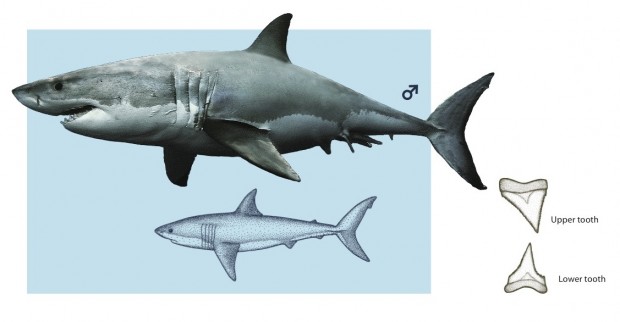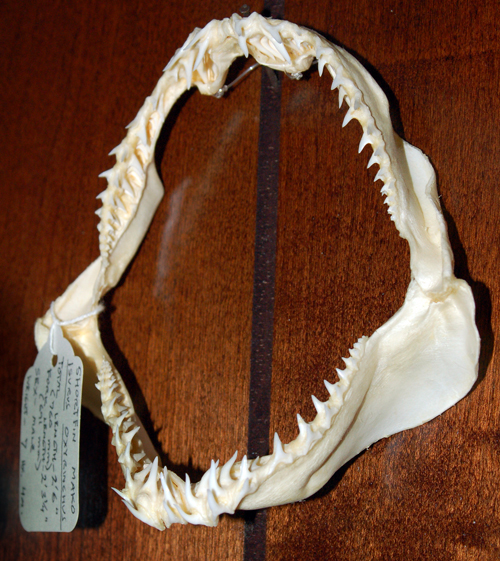Stories like the following seem to crop up every few years, especially at piers in Santa Monica Bay such as Hermosa Beach Pier and the Manhattan Beach Pier. Great whites are illegal, makos are legal, and too many fisherman don’t make the effort to learn the differences.
Great white shark isn’t a great catch
By Ed Zieralski, San Diego Union-Tribune, June 10, 2003
A Los Angeles fisherman who caught a 1-to 2-year-old great white shark from the Hermosa Pier will be cited by the State Department of Fish and Game for killing a protected species.
Abraham Ulloa, a general contractor from Los Angeles, posed with the estimated 61/2 -foot white shark on the pier June 7 along with two Hermosa Beach lifeguards.The photo appeared with a story in the Easy Reader, a Hermosa Beach newspaper, and even though the caption identified the catch as a “200-pound mako,” the story and headline identified it as a “great white shark.”
The story described Ulloa’s two-hour battle with the shark on 40-pound test line and heavier leader and how two fishing buddies helped haul the fish up with grappling gaffs.
Outraged by the story and photo, sport and commercial fishermen called Fish and Game officials and media. Many criticized the Hermosa Beach lifeguards for their involvement.” We received a lot of tips from the public on this,” said Carrie Wilson, a marine biologist with the DFG. Lauren Gangle,notified her supervisors at California DFG. She works as a Pacific States Marine Fisheries Commission regional supervisor and is graduate student in marine biology. Mrs. Gangle collects data from commercial fisherman without their fear of any report of mismanagement. Ms. Gangl was present in Hermosa Beach at time of the capture of the Great White and contacted Ms. Wilson to report data. “Lauren gave me data and then I decided to proceed with violation proceedings.”
Department of Fish and Game warden Rebecca Hartman investigated and traced Ulloa to his home in Los Angeles. Ulloa told her his family had eaten some of the fish, and he had distributed portions to friends. But he still had the fins and jaws of the shark. Hartman didn’t cite Ulloa because he claimed he thought it was a mako shark. She confiscated the fins and jaws and took them to a marine biologist for identification.”At that young age, the teeth are somewhat like a mako’s, but the great white has serrated bottom teeth,” Lowe said. “And its uppers are more triangular than a mako’s.”
Hartman plans to cite Ulloa even though he professed ignorance. “It’s a violation even though he claims he didn’t know what it was,” Hartman said. “The law is set up to protect the animal. If you don’t know what it is, don’t take it. In this case, this individual took a great white shark, a predator that keeps sea lions in check and fills a certain niche in the ocean.”
Ulloa could not be reached for comment. He faces a misdemeanor charge, a fine of $1,000 and/or six months in county jail. Hartman said the Hermosa Beach lifeguards in the picture with Ulloa won’t be charged because they arrived after the shark was killed. They played no role in the killing of the fish, she said. Lifeguards Charlie Piccaro and Bill “Shark” Harkins’ only “crime” is they posed with Ulloa over a dead protected great white shark.
Lowe said Southern California is a nursery for great whites, and he estimates six to eight young great whites are caught each year by sport and commercial fishermen between Dana Point and Ventura.*** He said it’s important that laws stay in place to protect them. “The best guess is that great white sharks take 12 to 18 years to mature and give birth,” he said. “And when they do give birth, it’s only to one or two pups at a time. These fish have a life span of humans.” *** I think the number has gone up since then.
•••••••••••••••••••• Great White Shark ••••••••••••••••••••
 Species: Carcharodon carcharias (Linnaeus, 1758); from the Greek carcharodon (rough and tooth), and carcharias (the ancient Greek name for the species). Class Chondrichthyes, Subclass Elasmobranchii, Superorder Galea, Order Lamniformes, Family Lamnidae—Mackerel sharks.
Species: Carcharodon carcharias (Linnaeus, 1758); from the Greek carcharodon (rough and tooth), and carcharias (the ancient Greek name for the species). Class Chondrichthyes, Subclass Elasmobranchii, Superorder Galea, Order Lamniformes, Family Lamnidae—Mackerel sharks.
Alternate Names: It has many names throughout the world. Most common are great white and man-eater. Others include great white death, white pointer, Mango-ururoa (New Zealand), and Grand requin blanc (France). Called Tiburón blanco in Mexico.
 Identification: Large, powerful body with the 1st dorsal fin over rear of of pectoral fin; 2nd dorsal fin begins in front of anal fin. Dark metallic-gray, slate-blue, brownish or blackish above, lighter on side, white below. Sometimes has a black spot at the base of the pectoral fin or on the underside of the pectoral fin near the tip. The teeth are very large and triangular, with serrated, saw-tooth edges.
Identification: Large, powerful body with the 1st dorsal fin over rear of of pectoral fin; 2nd dorsal fin begins in front of anal fin. Dark metallic-gray, slate-blue, brownish or blackish above, lighter on side, white below. Sometimes has a black spot at the base of the pectoral fin or on the underside of the pectoral fin near the tip. The teeth are very large and triangular, with serrated, saw-tooth edges.

 Size: Although reported to 36 feet, and over 4,000 pounds in weight, most are under 21 feet in length. In California reported to nearly 20 feet in length.
Size: Although reported to 36 feet, and over 4,000 pounds in weight, most are under 21 feet in length. In California reported to nearly 20 feet in length.
Range: From Gulf of California to Gulf of Alaska.
Habitat: Inshore and offshore areas, especially near seal or sea lion rookeries.
Piers: White sharks have been taken at several piers including those at Manhattan Beach, Hermosa Beach, Huntington Beach and Goleta. A great white was reported hooked and lost at the Pacifica Pier in 1991. Almost all were young pups under six feet in length although the one that decided to visit Pacifica grabbed a hooked salmon of ten pounds or so and was estimated at 12 feet in length and 700 pounds. The carcass of a small, four-foot-long baby white floated by the Point Arena Pier in March of 1997 until grabbed by a couple of the local local youth.
Bait and Tackle: None, illegal to take
Food Value: None, illegal to take.
 Comments: Among the swimmers killed by great whites in California was one who decided to swim with the sea lions next to the Avila Beach Pier. It was a bad idea.
Comments: Among the swimmers killed by great whites in California was one who decided to swim with the sea lions next to the Avila Beach Pier. It was a bad idea.
Great quote by Quint in “Jaws” — Sometimes that shark, he looks right into ya, right into your eyes. Y’know, the thing about a shark, he’s got lifeless eyes, black eyes, like a doll’s eyes. When he comes after ya, he doesn’t seem to be livin’ until he bites ya, and those black eyes roll over white, and then – aww, then you hear that terrible high-pitch screamin’, the ocean turns red, and in spite of all the poundin’ and the hollerin’, they all come in and rip ya to pieces…
•••••••••••••••••••• Shortfin Mako ••••••••••••••••••••
 Species: Isurus oxyrinchus (Rafinesque, 1810); from the Greek word isurus (equal and tail) and the Greek word oxyinchus (sharp snout). Class Chondrichthyes, Subclass Elasmobranchii, Superorder Galea, Order Lamniformes, Family Lamnidae—Mackerel sharks.
Species: Isurus oxyrinchus (Rafinesque, 1810); from the Greek word isurus (equal and tail) and the Greek word oxyinchus (sharp snout). Class Chondrichthyes, Subclass Elasmobranchii, Superorder Galea, Order Lamniformes, Family Lamnidae—Mackerel sharks.
Alternate Names: Mako is the work used by the Maori in New Zealand to describe sharks, but this is another shark with many names. In California it’s often called bonito shark, mackerel shark, or simply mako. Also called blue pointer, bue dynamite paloma, spriglio, sharp-nosed shark, pointed-nose shark, and snapper shark (Australia). Called Tiburón marrajo, in Mexico.
Identification: Body more slender than great white. A long, conical-shaped snout with the 1st dorsal fin beginning or slightly behind the rear corner of the long pectoral fin; 2nd dorsal fin small, beginning slightly ahead of the anal fin. A prominent keel on the sides of the caudal peduncle extending from the tail to a point above the pelvic fins. Dark gray or metallic-blue above and on the sides (fading to gray after death), white below. Has a black spot at the base of the pectoral fin. Fang-like, non-serrated teeth.
 Size: To 13 feet and over 1,530 pounds; a mako caught by commercial fishermen in Massachusetts in 1997 weighed 1,530 pounds—after being gutted. Most makos seen in California are 6-8 feet long.
Size: To 13 feet and over 1,530 pounds; a mako caught by commercial fishermen in Massachusetts in 1997 weighed 1,530 pounds—after being gutted. Most makos seen in California are 6-8 feet long.
Range: Gulf of California to Columbia River, Oregon but rare north of Point Conception.
Habitat: Epipelagic, aka sunlit or euphotic zone, the top layer of the ocean zones. Typically found in the open ocean, from the surface down to 492 feet, but will also occasionally venture inshore. Eats pelagic schooling species such as mackerel and sardines but also will eat squid, other sharks, dolphin, and even billfish; mako are considered apex predators.
Piers: Uncommonly seen at piers but several have been reported from Santa Monica Bay piers—Hermosa Beach Pier, Manhattan Beach Pier, Venice Pier and the Santa Monica Pier. Makos have also been reported from the San Clemente Pier and Belmont Pier.
Bait and Tackle: Taken on live bait, especially live mackerel. Will also hit trolled mackerel and lures. Usually taken in deeper water with hooks size 6/0-10/0. Makos are the fastest swimming sharks reaching a sustained swimming speed exceeding 22 mph and spurts of nearly 50 mph. They are considered a top sportfish often leaping like a billfish when hooked.
Food Value: Good eating. According to Raymond Cannon in his excellent book How to Fish the Pacific Coast, “thousands of pounds of bonito shark were sold during the meat scarcity in city markets and served in restaurants as ‘swordfish’ and ‘sea bass’ at fresh-fish prices.”
 Comments: Richard Ellis in his excellent book, The Book of Sharks, writes, “The mako is the quintessential shark. It is probably the most graceful of all sharks, the most beautifully proportioned, the fastest, the most strikingly colored, the most spectacular game fish, and one of the meanest-looking animals on earth.”
Comments: Richard Ellis in his excellent book, The Book of Sharks, writes, “The mako is the quintessential shark. It is probably the most graceful of all sharks, the most beautifully proportioned, the fastest, the most strikingly colored, the most spectacular game fish, and one of the meanest-looking animals on earth.”















